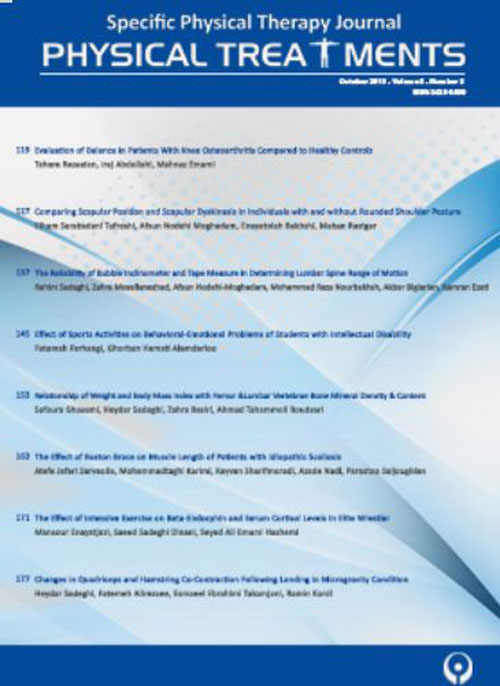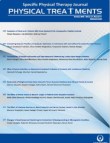فهرست مطالب

Physical Treatments Journal
Volume:8 Issue: 1, Spring 2018
- تاریخ انتشار: 1397/03/05
- تعداد عناوین: 7
-
-
Pages 1-8PurposeThe sensorimotor cortex oscillations (frequency ranging between 12 and 15 Hz), commonly known as Sensorimotor Rhythm (SMR) has previously displayed a promising link between the performance of the visuomotor related to skill execution and part of psychology that is adaptive (e.g. the process linked attention which is automatic). This study examined the extent of SMR power in the execution of both in- and anti-phase patterns in bimanual coordination tasks at different speeds.MethodsThe present study used a quasi-experimental method. Study participants (n=40, aged: 19-24 years) were selected using convenience sampling method. Study participants were subjected to the 2 bimanual movements with the wrists speed levels ranging from slow to fast; while taking simultaneous records of the EEG. The neurofeedback consisted of SMR frequency of 12-15 Hz at C3 and C4. Data analysis consisted of descriptive statistics and 2-way repeated measures Analysis of Variance (ANOVA) using SPSS. Examination of post-hoc results of importance was conducted using Bonferroni correction paired comparisons. P=0.05 was set as the significance level.ResultsThe results suggested that SMR power was higher in anti-phase compared to the inphase model. In addition, the manipulation of bimanual speed affected the SMR power by increasing it in the anti-phase when the speed increased. However, the SMR power did not raise when the in-phase pattern was conducted.ConclusionFurther attention is needed in the anti-phase model as it requires greater SMR power wave. Moreover, with increasing speed, the amount of SMR power can perform a better bimanual linear task.Keywords: Neurofeedback, Movement, Psychology, Psychomotorperformance, Athleticperformance
-
Pages 9-16PurposeCerebral Palsy (CP) can negatively affect dynamic stability in children with spastic diplegic Cerebral Palsy during walking. This condition results in a high risk of falling. There is limited evidence regarding the dynamic stability of children with Cerebral Palsy. Thus, this study aimed to investigate the dynamic stability of children with spastic diplegic Cerebral Palsy, compared to typically developed children during walking.MethodsSixteen children including 8 with spastic diplegic Cerebral Palsy and 8 normal ones with an age range of 5 to 8 years participated in this quasi-experimental study. A Qualysis motion analysis system capturing at a frequency of 100 Hz was used to record data. Qualysis software and Visual3D software were utilized for data extraction. Data analysis was conducted using the Independent t-test with P<0.05.ResultsThe stride length and velocity of gait in children with Cerebral Palsy were 32.25 cm and 0.34 m/s lower than the normal children, respectively. Center of mass displacement was 12.25% lower in anteroposterior plane and 1.23% higher in mediolateral plane in children with Cerebral Palsy, compared to the normal children. The margin of stability was 1.72 cm higher in the children with Cerebral Palsy, compared to normal children.ConclusionThe lower anteroposterior and higher mediolateral displacement of the center of mass result in an altered pattern of gait in children with Cerebral Palsy, compared to the normal children. Considering the aforementioned changes and the lower velocity of gait in children with Cerebral Palsy, the dynamic stability of children with spastic diplegic Cerebral Palsy is lower, compared to the normal children during walking.Keywords: Center of mass, Base of support, Dynamic stability, Cerebral Palsy
-
Pages 17-26PurposeEvaluation of joints behavioral symmetry of the lower limbs to produce a smooth, rhythmic movement is one of the topics in the field of biomechanics of running. This study investigated joints local and global symmetry while jogging in young male athletes.MethodsThis was a quasi-experimental study. Random sampling method was used and the participants of the study included 15 healthy young male athletes (Mean±SD age=27.14±3.67 years, Mean±SD height=176.57±5.06 cm, Mean±SD weight=69.84±6.13 kg). A 6-camera motion analysis system synchronized with 2 force plate devices and a 3D Marker-set were used for data collection. Participants ran with 155 bpm step frequency controlled by a metronome. After filtering the data, kinematic and kinetic parameters were calculated using inverse dynamics method and the calculated data were normalized based on body weight and 100% running gait cycle. Paired student t-test at the significance level of 0.05 was used for determining the differences between the selected peaks of ankle, knee and hip joints moment of the dominant and Non dominant limbs. The principal component analysis technique was used on the support phase of the sagittal plane joint moment in order to compare and evaluate functional asymmetry and identify each joint (local symmetry) and lower limb actions (global symmetry). SPSS was used for statistical analysis.ResultsBased on the findings, there were no significant differences in spatio-temporal parameters of the dominant and Non dominant limbs. Although, principal component analysis detected different functional tasks for similar joints, the same tasks were identified for the lower limbs using this method.ConclusionIt seems that local asymmetry and global symmetry occurs during jogging in young male athletes and central nervous system compensatory mechanisms might play an important role in this matter.Keywords: Jogging, Symmetry, Joint moment, Principal component analysis
-
Pages 27-36PurposeChanges in lower extremity alignment in individuals with abnormality of this segments are unclear. The present study aimed to compare lower extremity alignment in subjects with genu valgum and genu varum deformities and healthy subjects in order to understand the lower extremity alignment changes in this group.MethodsThis was a causal-comparative study. The sample comprised 120 males selected by convenience sampling method. In total, 40 subjects were assigned to genu valgum group, 40 to genu varum group, and 40 to healthy subject group. Lower extremity alignment was evaluated in anteversion of hip, Q angle, internal and external rotation of hip, knee hyperextension, tibial torsion, tibia vara, and foot arch index, at the laboratory of Tehran University, Tehran, Iran. To compare the mean score of variables between the groups, 1-way Analysis of Variance (ANOVA) was used. The obtained data were analyzed by SPSS.ResultsThe internal rotation of hip, Q angle, anteversion of hip, knee hyperextension and plantar arch index were significantly higher in the subjects with genu valgum deformity, compared to the subjects with genu varum deformity. The tibia vara value was significantly higher in the subjects with genu varum deformity than those with genu valgum deformity. However, no significant differences was found between the tibial torsion and external rotation of hip in the study groups.ConclusionThe lower extremity alignment changes in the subjects with genu valgum deformity included increased anteversion, Q angle, flatfoot, knee hyperextension, and internal rotation of the hip. Also, the changes in the subjects with genu varum deformity included decreased Q angle, internal rotation of hip, knee hyperextension, but increased tibia vara, and foot arch.Keywords: Genu valgum, Genuvarum, Lower extremityalignment
-
Pages 37-44PurposeThe present study aimed to compare Musculoskeletal Discomforts (MSDs) among six different common postures while working with laptop in female students of University of Tehran, Tehran City, Iran.MethodsThis was a crossover trial study. Eighteen female students voluntarily and purposefully participated in all stages of the study. The study participants were randomly assigned into groups to work for 10 minutes on different postures for laptop use during six continuous nights. MSDs was measured each night after 10 minutes of laptop use. For this purpose, Van der Grinten and Smith (1992) method was applied. The obtained data were analyzed by repeated measures one-way ANOVA at a significance level of P≤0.05, in SPSS.ResultsThe obtained results suggested a significant difference among six working postures in MSDs (P=0.005). The results of Bonferroni post hoc analysis revealed that the highest level of MSDs was observed in a cross-legged sitting position on the floor. While, the lowest level of MSDs was found in the sitting on a chair posture. In addition, the study participants who used a desk in order to increase the height of the laptop, reported less levels of MSDs than laptop use in the cross-legged position on the floor (P=0.039) or sitting on the bed (P=0.011).ConclusionAccording to this study, in order to minimize MSDs during working with laptop, it is recommended to use desk and chairs instead of sitting cross-legged on the floor or bed.Keywords: Musculoskeletal abnormalities, Students, Female, Posture, Computers
-
Pages 45-54PurposeBecause of the decrease in the quality of life caused by functional limitations and increase attention to functional ankle instability, this study investigated the attentional focus within 4 weeks of exercise therapy on performance improvement and the kinesiophobia in athletes with functional ankle instability.MethodsThis was a quasi-experimental study with pre-test post-test and control group design. In total, 37 female and male college student athletes of basketball, volleyball and futsal teams, who had functional ankle instability, were selected purposefully. After initial screening, the subjects were recruited based on the inclusion and exclusion criteria and then randomly divided into 3 groups of “internal focus”, “external focus”, and “without instruction”. Then, they performed the same training protocol but with different directions for 4 weeks. Health-related quality of life was investigated and compared between all 3 groups before and after exercises, using the Cumberland Ankle Instability Tool (CAIT) and Tampa Scale of Kinesiophobia (TSK- 17) scores. The obtained data were analyzed by SPSS. The Kolmogorov-Smirnov Test was used to assess the normal distribution of the study variables. Paired t-test was also used to compare within-group pre-test and post-test scores. Analysis of Covariance (ANCOVA) and Bonferroni post Hoc Test were used to compare between-group results, at the significance level of P≤0.05.ResultsPaired t test results revealed that after 4 weeks of exercise with wobble board, CAIT scores in all 3 training groups significantly increased regardless of the focal attention but TKS- 17 scores significantly decreased in all 3 groups (P≥0.05). The ANCOVA results demonstrated that after controlling the effect of pre-test (covariate), there were significant differences among 3 groups in post-test CAIT scores (P≥0.05). There were also significant differences among the 3 groups in post-test scores of TKS-17 (P≥0.05). Therefore, Bonferroni post hoc test was used to investigate the differences between the groups. The results of Bonferroni post-hoc test indicated that post-test CAIT scores in all 3 training groups increased significantly (P≥0.05) and TKS-17 scores in all 3 groups decreased significantly (P≥0.05).ConclusionApplying the “internal focus”, instructions within 4 weeks of exercise therapy to improve the quality of life associated in athletes with functional ankle instability is more effective than other guidelines or exercises without instructions.Keywords: Ankle injury, Attention, Exercise therapy, Qualityof Life
-
Pages 55-61PurposeHemipelvectomy amputation is a surgical procedure in which the lower limb and part of the pelvis are removed. Although few studies are available on the performance of individuals with hip disarticulation while walking, there is no study on gait analysis of hemipelvectomy subjects. Therefore, this study aimed to evaluate the gait and stability of an individual with hemipelvectomy amputation.MethodsAn individual with hemipelvectomy amputation on the right side participated in this study. He used a Canadian prosthesis with single axis ankle joint, 3R21 knee joint and 7E7 hip joint for more than 10 years. The kinetic and kinematic parameters were collected by a motion analysis system and a Kistler force plate.ResultsThere was a significant difference between knee, hip and ankle motion ranges and their related time periods on the sound and prosthesis sides. The stability of the subject was better in the anteroposterior direction, than the mediolateral direction. Results revealed a significant asymmetry between the sound and prosthesis sides.ConclusionThe obtained results suggested a significant asymmetry between the kinetic and kinematic performance of the sound and prosthesis sides, which may be due to lack of muscular power and alignment of prosthesis components.Keywords: Hemipelvectomy amputation, Canadian prosthesis, Gait analysis


